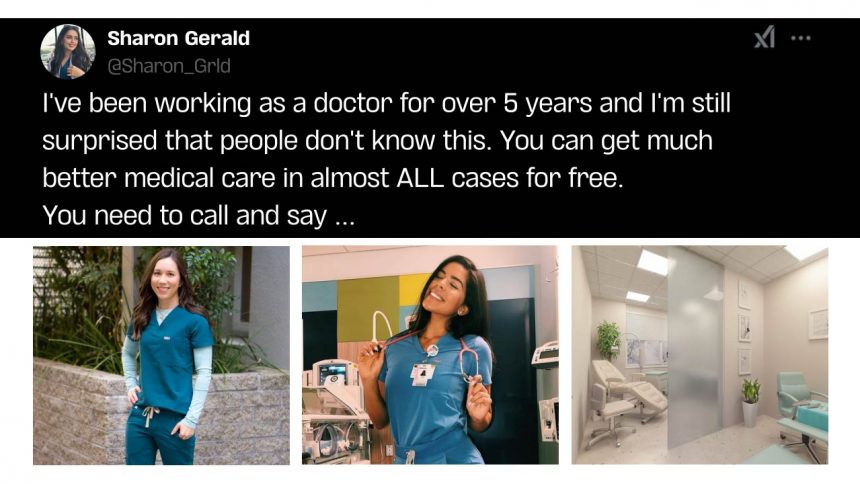For over five years as a practicing doctor, I’ve been privileged to care for patients from all walks of life. While the intricacies of the human body and the art of healing constantly amaze me, I’ve encountered a surprising and persistent gap in public knowledge: most people are unaware that they can access much better medical care in almost all cases—completely free of charge. The key lies in understanding how to navigate the system and knowing what to say.
Here’s what you need to know and why this knowledge can make a life-changing difference for you and your loved ones.
Understanding the Basics of Free Medical Care
In many countries, free or subsidized medical care is available through public healthcare systems, community health programs, or non-profit organizations. Yet, due to a lack of awareness or misinformation, countless individuals either overpay for private services or avoid seeking care altogether because they assume they can’t afford it. This gap often stems from not knowing the right channels to access these services or how to advocate for oneself effectively.
Whether it’s advanced diagnostic tests, specialist consultations, or life-saving treatments, many options are available without cost if you know where to look and who to call. The first step is understanding the healthcare infrastructure in your area.
Common Sources of Free Care
- Public Healthcare Systems: In countries with universal healthcare, such as the UK’s NHS or Canada’s Medicare, most essential services are covered. Even in nations without universal systems, public hospitals and clinics often provide free or low-cost services for those in need.
- Non-Profit Organizations: Many charities and NGOs focus on providing medical care to underserved populations. They often cover specialized areas such as cancer treatment, mental health services, or chronic disease management.
- Community Health Clinics: These clinics operate in many regions to provide accessible care regardless of a patient’s financial situation. Services range from vaccinations to dental care and routine check-ups.
- Educational Hospitals: Teaching hospitals affiliated with medical schools often offer free or reduced-cost care as part of their training programs for students and residents.
The Critical Step: Making the Call
Here’s where the magic happens. Once you’ve identified a potential source of free care, reaching out is essential. The problem is that many people don’t know how to navigate these conversations effectively. The key is understanding the system’s language and expressing your situation clearly.
When you call a clinic, hospital, or program, here’s what you should say:
“Hello, I’m looking for assistance with [specific medical need]. I’ve heard that your facility offers free or low-cost care. Could you guide me on the next steps or provide any resources that can help me?”
If you’re unsure where to start, explain your situation briefly:
“I’m currently uninsured/underinsured and facing financial difficulties. Are there programs or resources available to help someone in my position?”
Polite persistence is often necessary. Healthcare systems can be bureaucratic, but patient advocates, social workers, and community health representatives are usually eager to help if you reach out.
Overcoming Barriers to Access
Even when free care is available, several barriers can prevent people from utilizing it effectively:
- Fear or Stigma: Many individuals hesitate to seek assistance due to embarrassment or the belief that free care is substandard. In reality, these services are often on par with or better than private options.
- Lack of Documentation: Some programs require proof of income, residency, or other documents. Preparing these in advance can streamline the process.
- Language Barriers: Non-native speakers may struggle to navigate the system. Many institutions offer interpreters or multilingual staff to assist.
- Misinformation: Myths about eligibility or quality often deter people from seeking help. Reliable sources like official government websites or local healthcare authorities can clarify doubts.
Examples of Free Care in Action
Routine and Preventive Care
Preventive care—including vaccinations, annual check-ups, and screenings—is often available for free through public health initiatives. For instance, flu shots and mammograms are frequently provided at no cost in many countries.
Chronic Disease Management
Programs for managing conditions such as diabetes, hypertension, and asthma often include free consultations, medications, and educational workshops.
Emergency and Specialty Services
In emergencies, public hospitals are required to provide life-saving care regardless of a patient’s ability to pay. Additionally, specialty programs may offer free surgeries, cancer treatments, or mental health counseling.
Medications and Supplies
Some programs cover the cost of essential medications, medical devices, or rehabilitation equipment. Pharmacies partnered with public health departments may offer these items at no charge.
Why This Knowledge Matters
Understanding your rights and options within the healthcare system isn’t just about saving money; it’s about saving lives. Delaying or avoiding medical care due to financial concerns can have devastating consequences. By knowing how to access free services, you’re empowering yourself and your family to prioritize health without undue financial strain.
Spread the Word
If you’ve benefited from free medical care or know someone who has, share this knowledge. The more people are aware of these options, the healthier our communities can become. Advocate for transparency and accessibility within the healthcare system, and encourage others to do the same.
Final Thoughts
The next time you or someone you know needs medical attention, remember: help is often closer and more accessible than it seems. By calling the right places, asking the right questions, and persisting through challenges, you can unlock a world of high-quality care at no cost. Don’t let fear, stigma, or misinformation stand in the way of your health. Take that first step, make the call, and discover the resources available to you.





